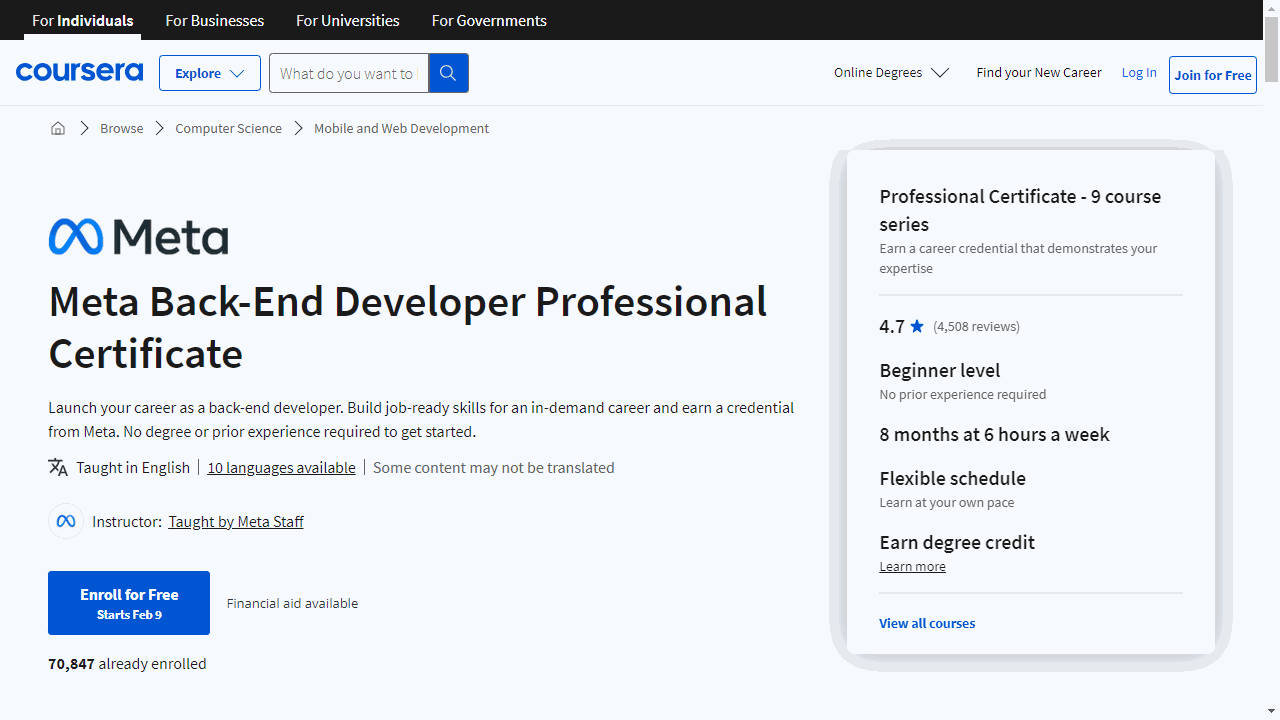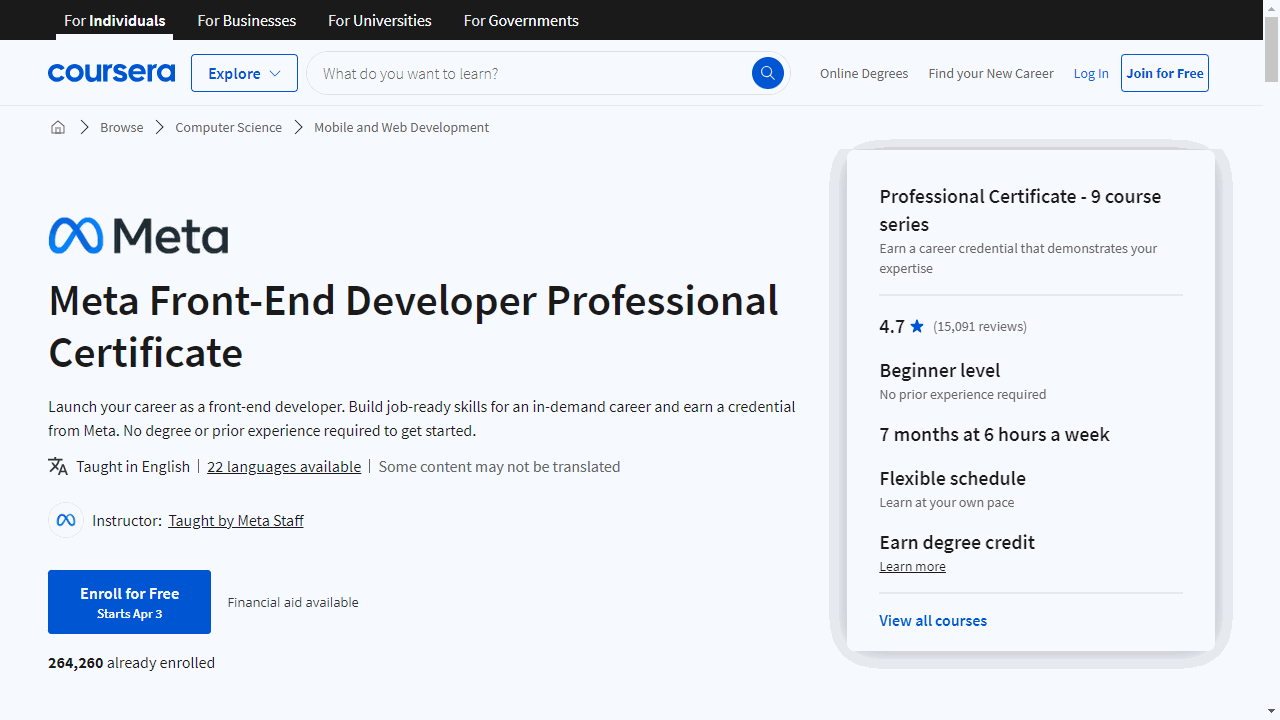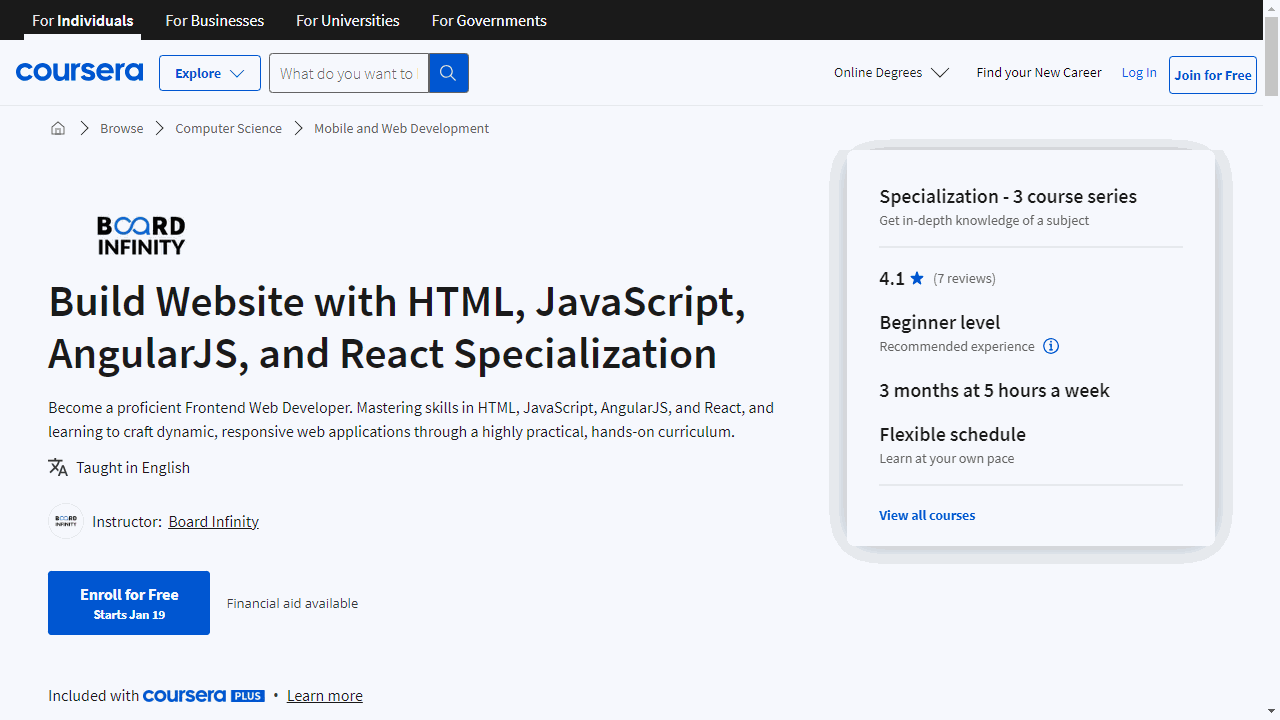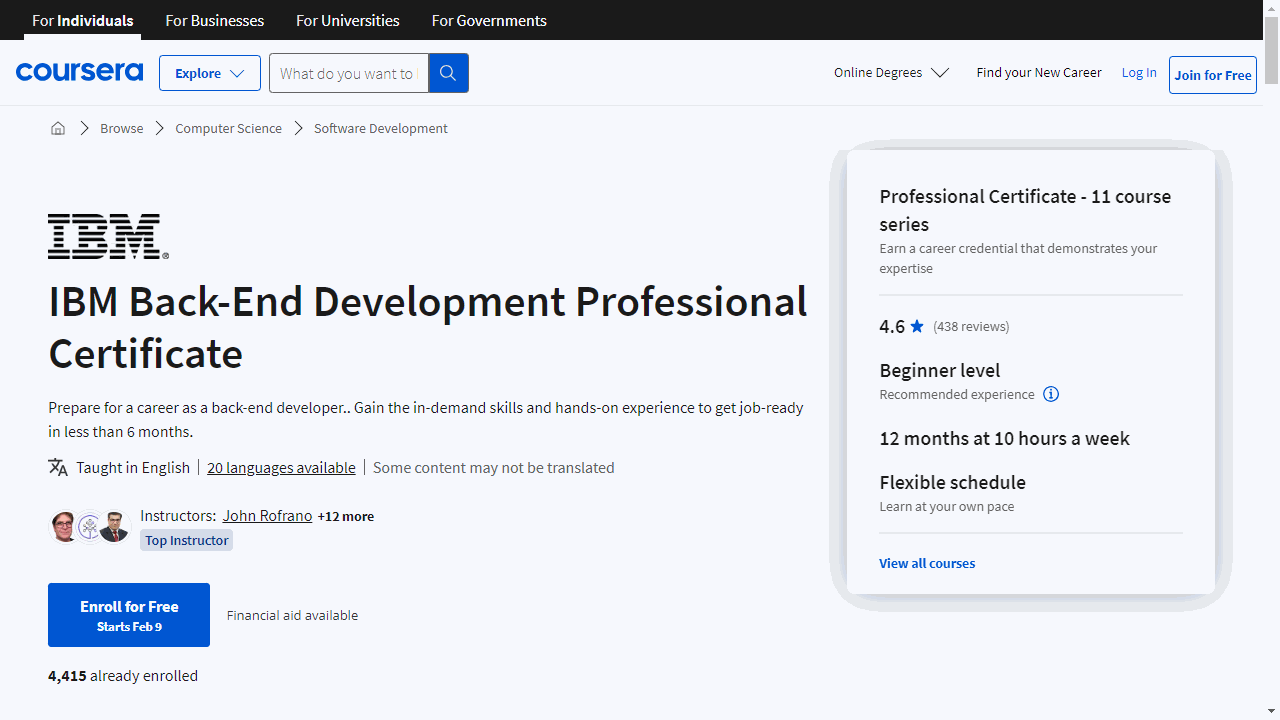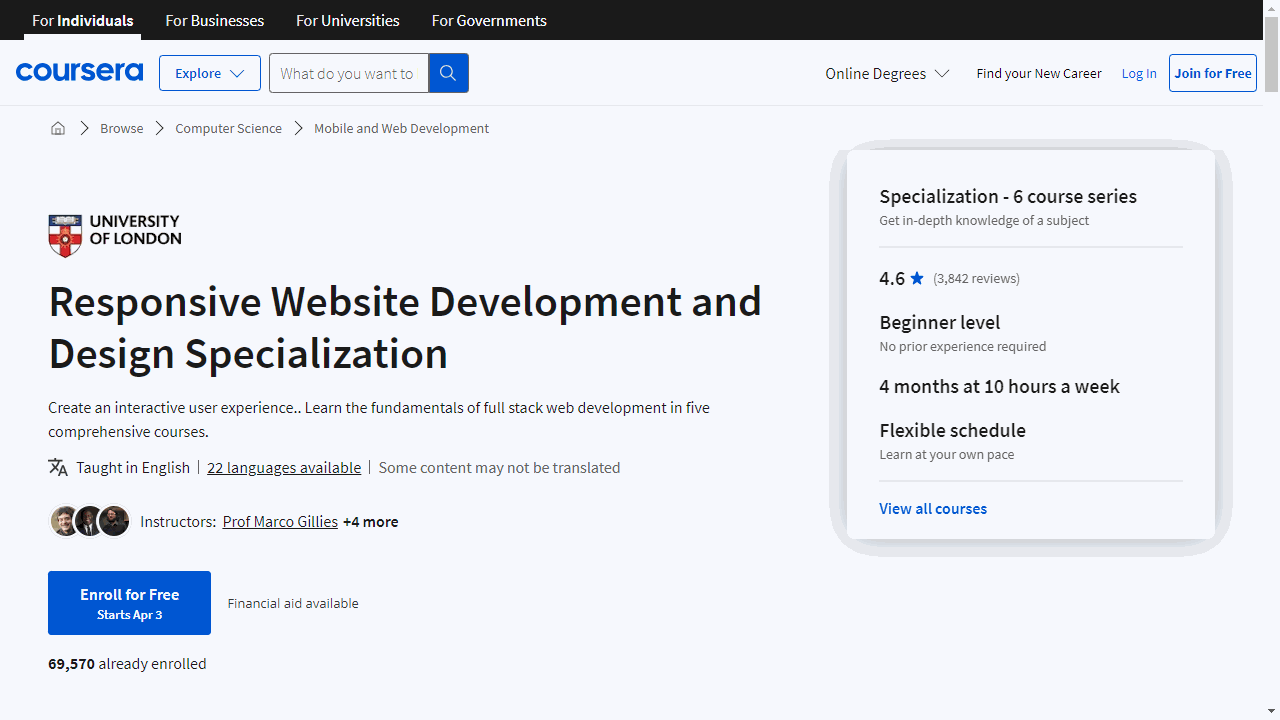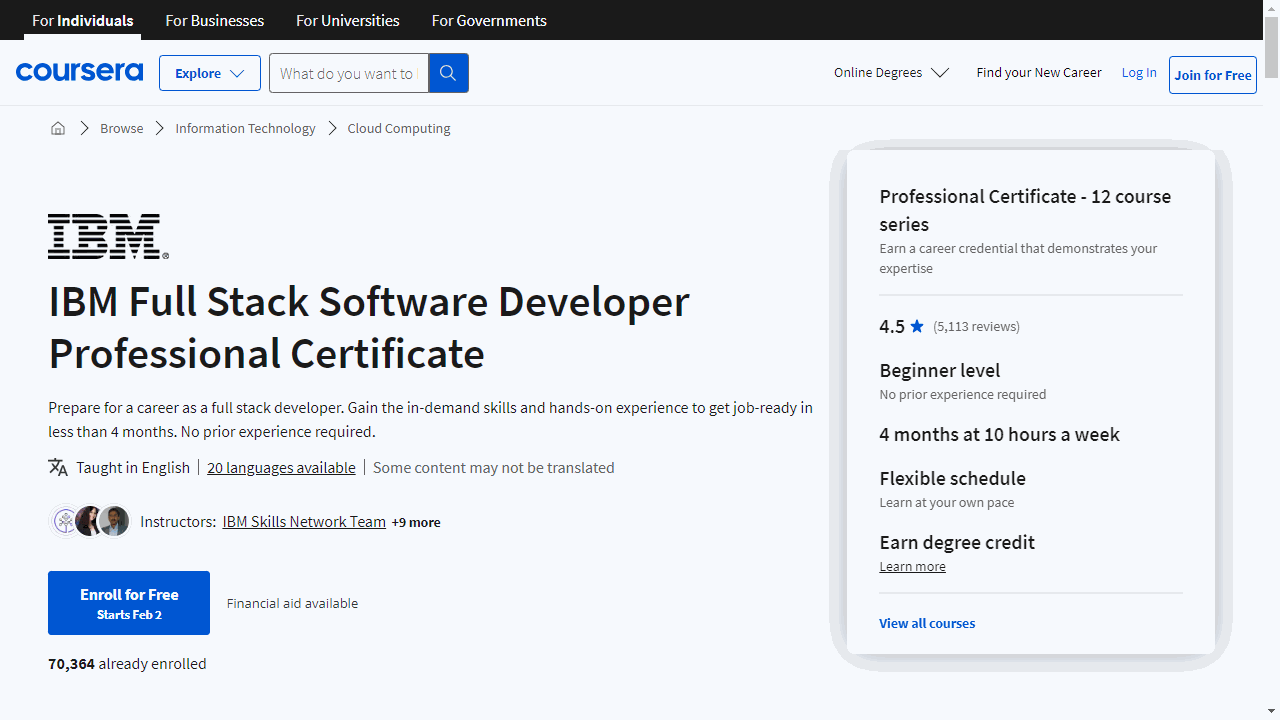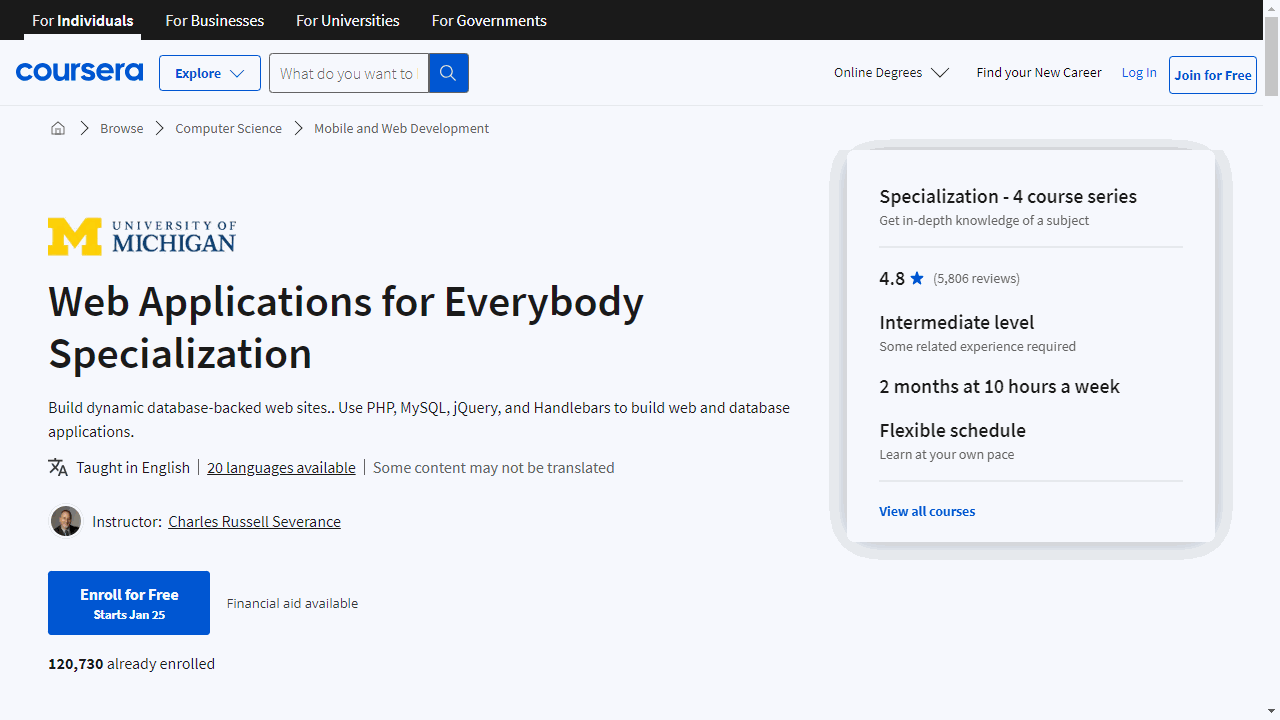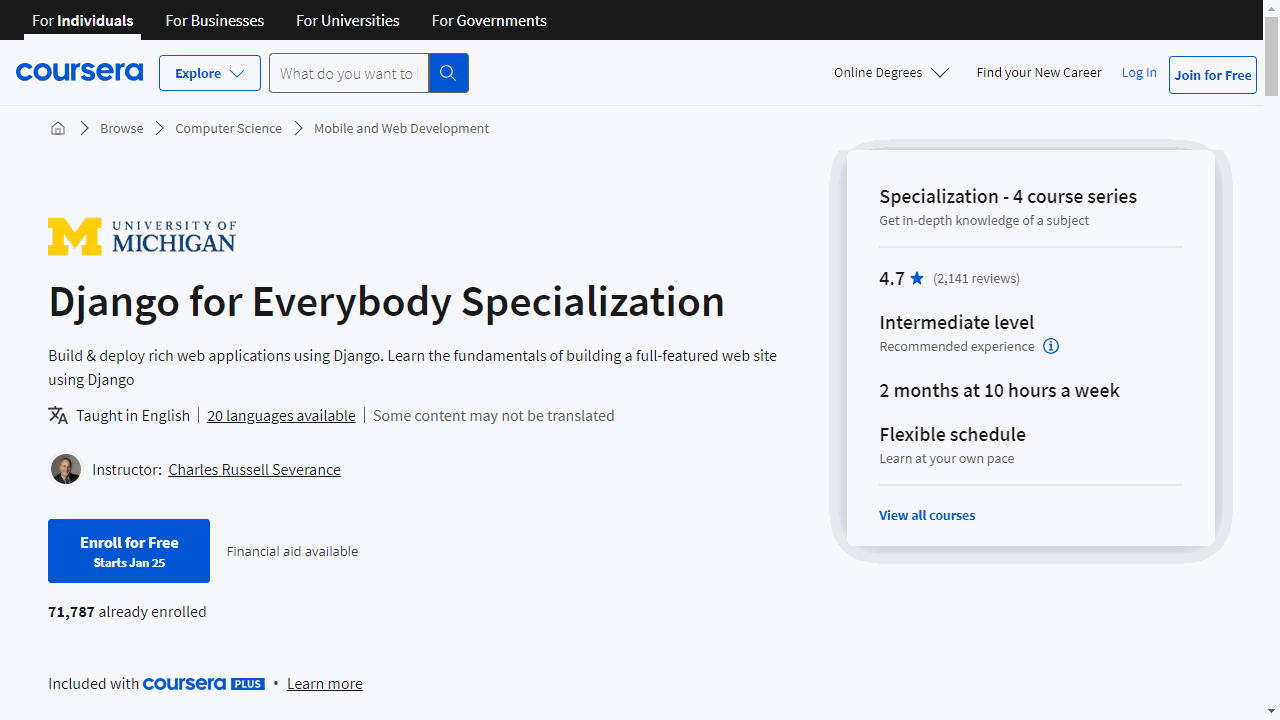Finding the right web development course on Coursera can be overwhelming with so many options to choose from.
You want a program that’s comprehensive, engaging, and taught by industry experts, but you also want to ensure it fits your learning style and career goals.
We’ve reviewed dozens of web development courses and certifications on Coursera and compiled this list of our top picks.
For the best overall web development program, we recommend the Meta Back-End Developer Professional Certificate.
This program offers comprehensive training in back-end technologies, covering topics from foundational HTML and CSS to advanced concepts like Python programming, Django web framework, and database management.
The hands-on projects and real-world applications make it a great choice for anyone serious about launching a career in back-end development.
And it has the added benefit of being taught by industry experts at Meta, one of the world’s leading tech companies.
We’ve also got recommendations for top front-end development programs, specializations focused on specific technologies like HTML, CSS, JavaScript, and React, and even programs that combine front-end and back-end skills to make you a full-stack developer.
Keep reading to find the perfect web development course for you.
Meta Back-End Developer Professional Certificate
The Meta Back-End Developer Professional Certificate is considered one of the top web development certifications on Coursera, offering comprehensive courses in back-end technologies.
You’ll start with the Introduction to Back-End Development course, where you’ll get a solid foundation in the core technologies that power the internet.
You’ll learn HTML and CSS to create and style webpages, and get an introduction to modern UI frameworks like Bootstrap and React.
Hands-on projects will have you building responsive layouts that look great on any device.
Next, you’ll dive into programming with Python.
You’ll learn the syntax, work with variables, data types, control flow, and functions.
Object-oriented programming concepts like classes and methods are covered.
Importantly, you’ll develop skills in error handling, testing, and writing clean, maintainable code.
With coding fundamentals in place, you’ll move on to essential developer tools.
The Version Control course introduces you to Git and GitHub for collaborating with other developers and managing code revisions.
You’ll also get comfortable with Linux commands and the Bash shell, enabling you to automate tasks and work efficiently.
Databases are a key part of back-end development, so you’ll spend time learning the concepts and practicing your skills.
You’ll explore different types of databases, use SQL to manipulate data, and even design your own relational database.
These skills will serve you well as you build applications that store and retrieve data.
At this point, you’ll be ready to learn the powerful Django web framework.
With Django, you’ll build a complete web application with data models, URL routes, views, and templates.
You’ll implement user registration, login, and security best practices.
After this course, you’ll have a solid understanding of full-stack development and how the front-end and back-end work together.
APIs are another critical back-end skill, and you’ll get plenty of practice working with them.
You’ll learn REST architecture principles and use Django to build API endpoints.
You’ll also explore different API styles and learn to test and document your APIs effectively.
In the Full Stack course, you’ll bring together all of your skills to build a complete Django application from scratch.
You’ll configure a development environment, build the front-end and back-end components, and connect to a MySQL database.
This project will reinforce your full-stack abilities and prepare you for real-world development tasks.
The Capstone project is your chance to showcase your skills by building a full-featured Django application.
You’ll implement a complete back-end with user authentication, API endpoints, and a MySQL database, all with clean, tested code and following best practices.
This project will be a valuable addition to your professional portfolio.
Finally, the Coding Interview Preparation course equips you with the problem-solving skills and computer science fundamentals you’ll need to succeed in a technical interview.
You’ll learn effective communication techniques, practice solving problems with code, and gain confidence in your ability to tackle coding challenges.
By the end of this program, you’ll have a solid foundation in back-end development and hands-on experience with the tools and technologies that power modern web applications.
Meta Front-End Developer Professional Certificate
This program, the best for front-end web development on Coursera, covers a wide range of topics, from the basics of HTML and CSS to advanced concepts like React and coding interview preparation.
In the Introduction to Front-End Development course, you’ll learn about the responsibilities of a web developer and gain a general understanding of the core technologies that power the internet.
You’ll be introduced to HTML and CSS, which are essential for creating and styling webpages.
You’ll also explore modern UI frameworks like Bootstrap and React, which make it easier to create interactive user experiences.
Next, in the Programming with JavaScript course, you’ll dive into the world of JavaScript, the programming language that powers modern web development.
You’ll learn how to work with functions, objects, arrays, variables, data types, and the HTML DOM.
You’ll also discover how to write unit tests using Jest, ensuring your code is reliable and maintainable.
The Version Control course will teach you how to collaborate effectively with other developers using tools like Git and GitHub.
You’ll learn how to navigate and configure using the command line, create repositories, and manage code revisions.
These skills are crucial for working on real-world projects with teams of developers.
In the HTML and CSS in depth course, you’ll further enhance your skills in creating attractive and responsive web pages.
You’ll learn how to use HTML5 and CSS to create forms, layouts, and user interfaces.
You’ll also explore debugging techniques to identify and fix common front-end errors.
The React Basics course will introduce you to the powerful JavaScript library, React.
You’ll learn how to build scalable and maintainable web applications using reusable components, props, and forms.
By the end of this course, you’ll be able to create dynamic and interactive web pages and apps using React.
Building upon the foundation laid in React Basics, the Advanced React course will teach you more advanced concepts and features.
You’ll learn how to render lists and form components efficiently, lift shared state, use advanced hooks, and build your own custom hooks.
You’ll also explore component composition techniques and advanced patterns like Higher Order Components and Render Props.
Additionally, you’ll learn how to test your React components and build a portfolio using React.
The Principles of UX/UI Design course will introduce you to the fundamentals of User Experience (UX) research and design.
You’ll learn how to empathize with users, create user personas, and design digital products that solve users’ problems.
You’ll also learn how to create wireframes and prototypes using Figma, following best practices in interaction design.
In the Front-End Developer Capstone course, you’ll have the opportunity to apply all the skills and knowledge you’ve acquired throughout the program.
You’ll work on a real-world project, combining React, JavaScript, HTML, and CSS to create a fully functional web application.
This capstone project will serve as a job-ready portfolio piece that you can showcase to potential employers.
Finally, the Coding Interview Preparation course will equip you with the best strategies and problem-solving skills needed to ace coding job interviews.
You’ll learn about appropriate communication during interviews, pseudocode, computer science fundamentals, data structures, and algorithms.
This course will give you the confidence and knowledge to succeed in technical interviews.
Build Website with HTML, JavaScript, AngularJS, and React Specialization
This series of courses will take you from the basics of HTML and CSS to the intricacies of JavaScript, React, and Angular, equipping you with the skills needed to create dynamic, responsive, and user-friendly web applications.
The first course, “Build a Webpage with HTML and CSS,” is the perfect starting point for beginners.
You’ll dive deep into the fundamentals of HTML, mastering the structure and usage of tags, attributes, and elements to define web content and layout.
But a webpage isn’t complete without style, and that’s where CSS comes in.
You’ll discover how to control layout, typography, and color schemes, bringing your pages to life.
And with Bootstrap, you’ll be able to create professional, mobile-friendly designs with ease.
Once you’ve got a solid foundation in HTML and CSS, it’s time to add some interactivity with “JavaScript for Web Development.”
This course will take you through the basics of JavaScript programming, from variables and data types to functions and event handling.
You’ll learn how to manipulate the Document Object Model (DOM) to dynamically modify web pages and create responsive user interfaces.
And with jQuery, you’ll be able to streamline your code and add even more advanced functionality.
But why stop there?
In “Libraries and Frameworks for Frontend Development,” you’ll explore two of the most popular tools for building web applications: React and Angular.
You’ll learn how to use React’s component-based architecture to create reusable UI elements and manage application state.
And with Angular, you’ll discover how to create scalable, modular applications with features like dependency injection and two-way data binding.
By the end of this specialization, you’ll have a portfolio of projects showcasing your newfound skills in web development.
You’ll be able to create visually stunning, responsive layouts with HTML and CSS, add dynamic content and interactivity with JavaScript and jQuery, and build robust, scalable applications with React and Angular.
Web Design for Everybody: Basics of Web Development & Coding Specialization
The Web Design for Everybody: Basics of Web Development & Coding Specialization on Coursera provides top-notch courses for beginners in web development.
This series of courses will take you from the basics of HTML5 and CSS3 to more advanced topics like responsive design and JavaScript interactivity.
The journey begins with the Introduction to HTML5 course, which assumes no prior programming experience.
You’ll learn the fundamentals of creating a simple webpage with links and images.
The emphasis is on understanding the theory behind web design, the practical skills needed to create your own pages, and the often-overlooked aspects of putting your code on the web for others to see.
Next, the Introduction to CSS3 course will teach you how to style your pages with fonts, colors, and layouts.
You’ll learn to write CSS rules, test your code, and develop good programming habits.
Accessibility is a key focus, ensuring your designs don’t put up barriers for users with cognitive or physical disabilities.
In the Interactivity with JavaScript course, you’ll take your pages to the next level by adding dynamic elements.
You’ll learn the basics of JavaScript, including variables, looping, functions, and debugging.
By understanding the Document Object Model (DOM), you’ll be able to make your pages react to user events like mouse clicks and keyboard input.
The Advanced Styling with Responsive Design course prepares you for the reality that your pages will be viewed on a variety of devices, from smartphones to desktop computers.
You’ll learn to create designs that adapt to different screen sizes and user preferences using media queries and existing frameworks like Bootstrap.
Finally, the Web Design for Everybody Capstone project allows you to showcase your new skills by creating a responsive, accessible web portfolio.
You’ll create wireframes, implement the designs, and get feedback from peers and instructors.
By the end of this specialization, you’ll have a solid foundation in HTML, CSS, and JavaScript.
You’ll be able to create responsive, accessible websites that work across a range of devices.
IBM Front-End Developer Professional Certificate
Through a series of well-structured courses, you will embark on a journey that covers the essential aspects of front-end development, from the fundamentals to advanced techniques.
Starting with the “Getting Started with Front-End and Web Development” course, you will gain a solid understanding of the significance of user interface (UI) and user experience (UX) design.
You will explore the inner workings of web browsers and the internet, familiarizing yourself with the tools and technologies that enable the creation of interactive and engaging websites.
The course also introduces you to No-Code development and Content Management Systems (CMS), providing a well-rounded foundation for your journey.
As you progress through the program, you will dive into the world of software engineering with the “Introduction to Software Engineering” course.
Here, you will learn about the Software Development Lifecycle (SDLC) and modern development methodologies like Agile and Scrum.
You will explore fundamental programming principles using Python and gain hands-on experience with an integrated development environment (IDE).
The “Designing User Interfaces and Experiences (UI/UX)” course is where you will hone your skills in creating visually appealing and user-friendly interfaces.
You will learn about typography, readability, color theory, and responsive web design (RWD).
The course introduces you to Figma, a powerful collaborative design tool, enabling you to create stunning designs and prototypes.
In the “Introduction to HTML, CSS, & JavaScript” course, you will dive into the core technologies that power the web.
You will learn how to structure web pages using HTML, style them with CSS, and add interactivity with JavaScript.
Through hands-on labs and projects, you will gain practical experience in building dynamic and engaging websites.
The “Developing Websites and Front-Ends with Bootstrap” course focuses on leveraging the power of the popular CSS framework, Bootstrap.
You will learn how to create responsive and flexible websites quickly and efficiently using Bootstrap’s extensive set of templates and components.
The course also covers integrating Bootstrap with React, a popular JavaScript library for building user interfaces.
Version control is an essential skill for any developer, and the “Getting Started with Git and GitHub” course will introduce you to collaborative coding and popular Git platforms.
You will learn how to create repositories, work with branches, and collaborate effectively as a team using GitHub.
The course culminates in a final project where you will build your portfolio by creating and sharing an open-source project on GitHub.
The “Developing Front-End Apps with React” course dives deep into the world of React, one of the most popular frameworks for building rich front-end applications.
You will learn how to build dynamic user interfaces using React components, manage state and props, and integrate with external services using HTTP requests.
The course also covers advanced topics like hooks and Redux, empowering you to build complex and scalable applications.
In the “Intermediate Web and Front-End Development” course, you will explore techniques to optimize your websites for search engines (SEO) and improve the user experience.
You will learn about automated build tools like Webpack, testing frameworks like Mocha and Jasmine, and debugging techniques using Google Chrome DevTools.
The “Get Started with Cloud Native, DevOps, Agile, and NoSQL” course introduces you to the world of cloud-native application development.
You will explore concepts like Continuous Integration and Continuous Delivery (CI/CD), Agile methodologies, and Scrum practices.
The course also covers MongoDB, a popular NoSQL database, and IBM Cloudant, providing you with a solid understanding of data storage and management in modern web applications.
The program culminates in the “Front-End Development Capstone Project,” where you will apply all the skills and knowledge gained throughout the courses to design and develop a fully functional responsive website.
You will showcase your proficiency in HTML, CSS, React, and GitHub, creating a impressive addition to your professional portfolio.
Finally, the “Software Developer Career Guide and Interview Preparation” course equips you with the tools and strategies to navigate the job market successfully.
You will learn how to create a compelling resume, build a portfolio, and prepare for technical interviews.
The course provides valuable insights from industry experts, helping you gain a competitive edge in your job search.
IBM Back-End Development Professional Certificate
Through a series of well-structured courses, you’ll gain a solid foundation in software engineering principles, programming languages, and modern development methodologies like Agile and Scrum.
Starting with the Introduction to Software Engineering course, you’ll explore the Software Development Lifecycle (SDLC) and get hands-on experience with an IDE and programming basics in Python.
You’ll also learn about application architecture, design patterns, and deployment strategies.
Next, the Hands-on Introduction to Linux Commands and Shell Scripting course will familiarize you with essential Linux commands and Bash shell scripting.
You’ll interact with the Linux Terminal, navigate directories, manage files, and schedule tasks using crontab.
The course includes hands-on labs on a virtual Linux server, allowing you to practice your skills without the need for local installations.
In the Getting Started with Git and GitHub course, you’ll dive into collaborative version control and social coding.
You’ll learn Git concepts like branching, forking, and merging, and use GitHub to work effectively in a team.
The course culminates in a final project where you’ll create and share an open-source GitHub project, adding to your portfolio.
The Python for Data Science, AI & Development course will take you from zero to programming in Python, covering data types, data structures, logic, and libraries like Pandas, Numpy, and Beautiful Soup.
You’ll also learn to access web data using APIs and web scraping in Jupyter Notebooks.
In the Developing AI Applications with Python and Flask course, you’ll apply your Python skills to develop AI-enabled applications.
You’ll create modules, run unit tests, and package applications using Flask and IBM Watson AI Libraries.
The Django Application Development with SQL and Databases course will teach you foundational database concepts, SQL, and Object-Relational Mapping (ORM).
You’ll create a full-stack Django web app that persists, processes, and presents data, and deploy it on the cloud.
Introduction to Containers w/ Docker, Kubernetes & OpenShift will familiarize you with containerization tools and technologies.
You’ll learn about Docker objects, Kubernetes CLI, and the similarities and differences between OpenShift and Kubernetes.
By the end of the course, you’ll be able to build, deploy, and scale containerized applications on the cloud.
In the Application Development using Microservices and Serverless course, you’ll create microservices using REST APIs, Python, and Flask.
You’ll also learn about serverless applications and deploy them on IBM Cloud Code Engine.
The Application Security for Developers and DevOps Professionals course will help you identify vulnerabilities and implement secure coding practices.
You’ll learn about DevSecOps, SAST, OWASP top risks, and the importance of monitoring and observability in maintaining secure systems.
Monitoring and Observability for Development and DevOps dives deeper into these concepts, covering the three pillars of observability and popular tools like Prometheus, Grafana, Mezmo (LogDNA), and Instana.
You’ll gain hands-on experience with OpenTelemetry and tracing for container applications.
Finally, the Back-end Application Development Capstone Project will challenge you to develop, deploy, and integrate a microservices-based application using the skills and technologies learned throughout the certificate.
You’ll work with Flask, Django, NoSQL, MongoDB, Kubernetes, OpenShift, and serverless, adding a substantial project to your portfolio.
The hands-on labs and projects will give you the practical experience needed to confidently apply your skills in real-world scenarios.
Responsive Website Development and Design Specialization
The Responsive Website Development and Design Specialization on Coursera is one of the best specializations for learning responsive web development techniques.
The first course, Responsive Website Basics: Code with HTML, CSS, and JavaScript, lays the foundation by teaching you the three key languages for web development.
You’ll learn how to create a basic web page using HTML, control its layout and style with CSS, and add interactivity with JavaScript.
The course also introduces responsive design using libraries like Bootstrap.
Building upon these fundamentals, the Responsive Web Design course dives into interaction design and human-computer interaction principles.
You’ll learn how to create wireframe mockups, use Bootstrap components to implement designs, and leverage JavaScript data structures and templates to separate data from display.
By the end, you’ll be able to create responsive and interactive web pages.
Next, the Introduction to Meteor.js Development course takes you into the world of full-stack web development.
With Meteor.js and MongoDB, you’ll build a complete multi-user website from scratch.
You’ll implement features like user authentication, security, reactive templates, and routing using Iron Router.
This course provides hands-on experience with key database operations and building a functional application line by line.
The Web Application Development with JavaScript and MongoDB course further enhances your skills.
You’ll learn advanced techniques like controlling data access with methods, using publish and subscribe, and validating data with SimpleSchema.
You’ll also gain experience with command-line tools and automatically generating input forms.
The course culminates in building a collaborative code editing environment called TextCircle.
In the Responsive Website Tutorial and Examples course, you’ll explore exciting examples of interactive web applications that incorporate media, sound, images, and big data.
You’ll learn how to build similar sites using Meteor, work with external data sources, create realtime collaborative environments, and use media APIs like the Web Audio API.
The course provides fully working example code for your own projects.
Finally, the Responsive Website Development and Design Capstone allows you to apply all the skills you’ve learned throughout the specialization.
You’ll create a complete, responsive, multi-user, data-driven website to solve a problem of your choice.
The capstone takes you through the entire development process, from idea generation to product delivery, with structured assignments and peer feedback.
By completing this specialization, you’ll gain a solid foundation in web development and be able to create responsive, interactive, and data-driven websites.
The courses cover a wide range of technologies, including HTML, CSS, JavaScript, MongoDB, Meteor.js, and various libraries and APIs.
IBM Full Stack Software Developer Professional Certificate
This program covers a wide range of essential topics and technologies, making it suitable for beginners and experienced developers alike.
You’ll start with an introduction to cloud computing, learning about key concepts, service models like IaaS, PaaS, and SaaS, and offerings from major providers such as AWS, Google Cloud, Microsoft Azure, and IBM Cloud.
This foundational knowledge will help you understand the modern web development landscape.
Next, you’ll dive into web development fundamentals with HTML, CSS, and JavaScript.
You’ll learn how to structure webpages, style them with CSS, and add interactivity using JavaScript.
Hands-on labs will give you practical experience building websites from scratch.
To collaborate effectively with other developers, you’ll explore Git and GitHub.
You’ll learn about version control, branching, repositories, and common workflows.
This is a crucial skill for any developer working on team projects.
As you progress, you’ll discover powerful frameworks and libraries.
React, one of the most popular front-end frameworks, allows you to build dynamic user interfaces efficiently.
On the back-end, you’ll work with Node.js and Express to create server-side applications and RESTful APIs.
Python is another key language covered in this program.
You’ll learn Python basics and how to use libraries like Pandas, Numpy, and Beautiful Soup for data science and web scraping.
You’ll even build AI applications using Python and Flask.
Database skills are essential for back-end development.
You’ll learn SQL fundamentals and how to use Django, a Python web framework, to work with databases using Object-Relational Mapping (ORM).
This will enable you to build full-stack applications that persist and process data.
The program also covers cutting-edge technologies like containers and serverless computing.
You’ll use Docker and Kubernetes to package and deploy applications consistently across environments.
With serverless platforms like IBM Cloud Code Engine, you’ll build microservices that scale automatically without managing infrastructure.
Throughout the courses, you’ll complete hands-on labs and projects to reinforce your learning.
The capstone project is a fantastic opportunity to showcase your full-stack skills by building and deploying a real-world application using CI/CD pipelines.
By the end of this program, you’ll have a strong foundation in web development, cloud computing, and modern software engineering practices.
You’ll be well-prepared for roles like front-end developer, back-end developer, full-stack developer, cloud engineer, and more.
Web Applications for Everybody Specialization
Through a series of four courses, you’ll embark on a journey that takes you from the basics of how web browsers interact with servers, to building full-fledged web applications using PHP, MySQL, JavaScript, and jQuery.
In the first course, Building Web Applications in PHP, you’ll explore the fundamental concepts behind web development.
You’ll learn about the request/response cycle and how HTML, CSS, and PHP work together to create interactive web pages.
By the end of this course, you’ll be able to install a PHP/MySQL environment like XAMPP or MAMP and build your first simple web application.
Next, the Introduction to Structured Query Language (SQL) course will teach you how to work with databases using SQL.
You’ll learn how to design databases with multiple tables, define relationships using foreign keys, and perform complex queries with JOIN operations.
This knowledge will be essential as you move on to building more advanced web applications that rely on persistent data storage.
Building upon your PHP and SQL skills, the Building Database Applications in PHP course will introduce you to object-oriented programming concepts in PHP.
You’ll learn how to connect to a MySQL database using the PDO library and perform CRUD (Create, Read, Update, Delete) operations on your data.
This course will also cover important web development topics such as handling cookies, managing session data, and implementing user authentication.
Finally, the JavaScript, jQuery, and JSON course will round out your web development skill set by teaching you how to add interactivity to your web pages using JavaScript and the popular jQuery library.
You’ll learn about the Document Object Model (DOM) and how to manipulate it using jQuery to create dynamic user interfaces.
Additionally, you’ll explore how to exchange data between the server and the browser using JSON.
By the end of this specialization, you’ll have a solid foundation in web development and be able to build your own full-stack web applications using PHP, MySQL, JavaScript, and jQuery.
Django for Everybody Specialization
This series of four courses will take you on a journey from the basics of web applications to building full-featured sites using the powerful Django framework.
In the first course, Web Application Technologies and Django, you’ll explore the fundamental concepts behind web development.
You’ll learn about the request-response cycle of the Hypertext Transfer Protocol (HTTP) and how web browsers interact with servers.
You’ll also get hands-on experience with HTML and CSS to create and style web pages.
By the end of this course, you’ll be able to deploy a simple Django application on a platform like PythonAnywhere.
Building upon this foundation, the second course, Building Web Applications in Django, focuses on data modeling and database interactions.
You’ll discover how Django uses Object-Relational Mapping (ORM) to communicate with databases through model objects.
You’ll learn basic SQL and how to define relationships between database tables.
The course also covers object-oriented programming concepts in Python and how to build HTML forms.
In the third course, Django Features and Libraries, you’ll learn how to create user-friendly web applications.
You’ll explore essential features like cookies, sessions, and authentication to manage user interactions.
The course will guide you through improving the navigation and appearance of your Django apps.
You’ll start building a classified ads website that showcases various web development techniques.
The final course, Using JavaScript and JSON in Django, introduces you to the world of client-side programming.
You’ll learn the fundamentals of JavaScript and its unique approach to object-oriented programming.
The course also covers the popular jQuery library for manipulating the Document Object Model (DOM) and handling events in the browser.
You’ll discover how JSON is used to exchange data between the server (Django) and the client (JavaScript/jQuery).
Throughout the course, you’ll continue enhancing your classified ads application with interactive features.
By the end of this specialization, you’ll have a solid understanding of web development concepts and the skills to build dynamic, data-driven websites using Django.
You’ll be able to create engaging user interfaces, handle user authentication, and interact with databases.
Final Words
Coursera offers an impressive selection of top-rated web development courses, specializations, and professional certifications.
Whether you’re a beginner looking to learn the basics of HTML, CSS, and JavaScript, or an experienced developer seeking to master advanced frameworks like React, Angular, or Django, Coursera has you covered.
These programs, taught by industry experts and leading companies, provide comprehensive training in front-end, back-end, and full-stack web development.
You’ll gain hands-on experience with essential tools and technologies, including version control with Git and GitHub, databases like SQL and MongoDB, containerization with Docker and Kubernetes, and cloud deployment.
Many of these web development specializations culminate in capstone projects, allowing you to apply your newfound skills to build impressive, job-ready portfolios.
Additionally, courses like Coding Interview Preparation and Software Developer Career Guide equip you with the strategies and problem-solving skills needed to succeed in technical interviews and launch your career.
With Coursera’s flexible online learning format, you can study at your own pace, fitting coursework around your schedule.
Investing in one of these web development specializations can be a game-changer, opening doors to exciting career opportunities in this rapidly growing field.
